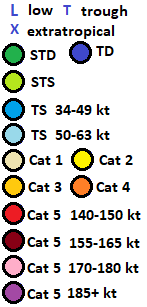Verification of tracks made of Douglas
I made seven tracks of Hurricane Douglas, before it was assessed as
a tropical cyclone. I made two more tracks after that point. Additionally, within 480
hours of cyclogenesis, there were five instances,
when I missed cyclogenesis entirely. Peak intensity was consistently underestimated, and Douglas was expected to remain too far south.
Exiting the margin of East Pacific tracking map through left edge (about 164 W) is considered equal to dissipation for the purposes of this verification.
As of this analysis, tropical cyclone report or best track positions are available July 18, 12Z
thru July 29, 12Z, and as such, position comparisons are possible only
for this timespan.
Since I give only SSHS categories in my tracks, I don't
calculate intensity errors in units of speed, but in categories. For
this purpose, I define tropical or subtropical storms as "Category 0", tropical
or subtropical depressions as "Category -1" and non-existence of a tropical or subtropical cyclone as
"Category -2".
In the seven tracks (made before operationally recognized cyclogenesis),
formation times ranged between July 18, 06Z and July 23, 00Z. Average
was July 20, 17Z and median was July 20, 06Z.
In the fourteen cases (9 tracks, before the tracks and data agreed, that Category 4 would remain the peak intensity, and 5 complete
misses), peak intensity ranged between Category -2 and Category 3.
Average was Category 0.29 and median was Category 1.
In the nine tracks (made before operationally recognized degeneration
into remnant low), dissipation times ranged between July 25, 18Z
and July 29, 12Z. Average was July 27, 17Z and median was July 28, 00Z.
At the lead time of 1 day (24 hours), there were 2 hits, 0 false detections and 2 misses. 2 available position comparisons produce an average error of 47 nautical miles.
At the lead time of 2 days (48 hours), there were 3 hits, 0 false detections and 2 misses. 3 available position comparisons produce an average error of 90 nautical miles.
At the lead time of 3 days (72 hours), there were 3 hits, 0 false detections and 3 misses. 3 available position comparisons produce an average error of 101 nautical miles.
At the lead time of 4 days (96 hours), there were 4 hits, 0 false detections and 3 misses. 4 available position comparisons produce an average error of 153 nautical miles.
At the lead time of 5 days (120 hours), there were 4 hits, 0 false detections and 3 misses. 4 available position comparisons produce an average error of 210 nautical miles.
At the lead time of 6 days (144 hours), there were 4 hits, 0 false detections and 3 misses. 4 available position comparisons produce an average error of 254 nautical miles.
At the lead time of 7 days (168 hours), there were 4 hits, 1 false detection and 3 misses. 5 available position comparisons produce an average error of 266 nautical miles.
At the lead time of 8 days (192 hours), there were 5 hits, 1 false detection and 3 misses. 6 available position comparisons produce an average error of 233 nautical miles.
At the lead time of 9 days (216 hours), there were 4 hits, 2 false detections and 4 misses. 6 available position comparisons produce an average error of 258 nautical miles.
At the lead time of 10 days (240 hours), there were 4 hits, 0 false detections and 4 misses. 4 available position comparisons produce an average error of 165 nautical miles.
At the lead time of 11 days (264 hours), there were 4 hits, 0 false detections and 2 misses. 4 available position comparisons produce an average error of 171 nautical miles.
At the lead time of 12 days (288 hours), there were 4 hits, 0 false detections and 3 misses. 4 available position comparisons produce an average error of 220 nautical miles.
At the lead time of 13 days (312 hours), there were 4 hits, 0 false detections and 2 misses. 4 available position comparisons produce an average error of 279 nautical miles.
At the lead time of 14 days (336 hours), there were 4 hits, 0 false detections and 2 misses. 4 available position comparisons produce an average error of 333 nautical miles.
At the lead time of 15 days (360 hours), there were 1 hit, 0 false detections and 4 misses. 1 available position comparison produces an average error of 160 nautical miles.
At the lead time of 16 days (384 hours), there were 0 hits, 0 false detections and 4 misses. No available position comparisons.
At the lead time of 17 days (408 hours), there were 0 hits, 0 false detections and 3 misses. No available position comparisons.
At the lead time of 18 days (432 hours), there were 0 hits, 0 false detections and 3 misses. No available position comparisons.
At the lead time of 19 days (456 hours), there were 0 hits, 0 false detections and 2 misses. No available position comparisons.
At the lead time of 20 days (480 hours), there were 0 hits, 0 false detections and 2 misses. No available position comparisons.
Circle coloration scheme
Here are the tracks once again.
July 10, 06Z:
July 11, 12Z:
July 12, 12Z:
July 13, 12Z:
July 18, 06Z:
July 19, 06Z:
July 20, 06Z:
July 22, 06Z:
July 23, 12Z:
The complete misses were from the following model cycles:
July 7, 12Z
July 8, 06Z
July 15, 12Z
July 16, 06Z
July 17, 12Z










Comments
Post a Comment